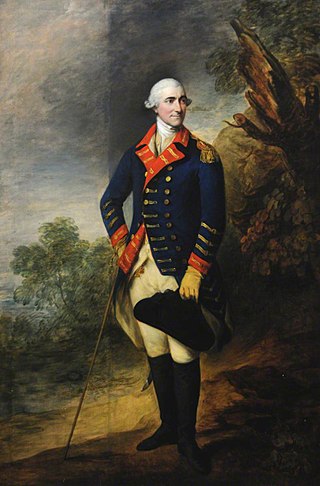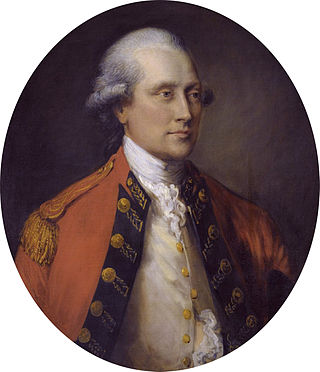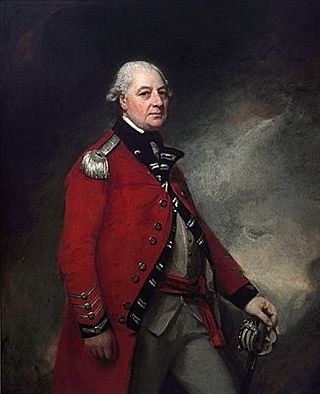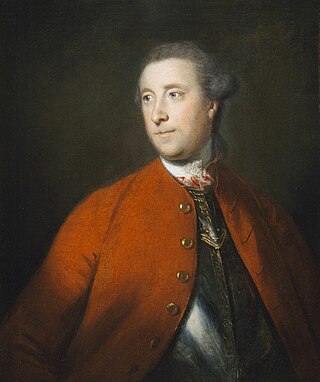Related Research Articles

Field Marshal Henry Seymour Conway was a British general and statesman. A brother of the 1st Marquess of Hertford, and cousin of Horace Walpole, he began his military career in the War of the Austrian Succession. He held various political offices including Chief Secretary for Ireland, Secretary of State for the Southern Department, Leader of the House of Commons and Secretary of State for the Northern Department. He eventually rose to the position of Commander-in-Chief of the Forces.

Field Marshal John Ligonier, 1st Earl Ligonier,, was a French Huguenot exile, born Jean Louis de Ligonier in Castres, Southern France. He had a long and distinguished career in the British army and was appointed Commander-in-chief in 1757.

Field Marshal Sir Robert Rich, 4th Baronet was a British cavalry officer. As a junior officer he fought at the Battle of Schellenberg and at the Battle of Blenheim during the War of the Spanish Succession. He was then asked to raise a regiment to combat the threat from the Jacobite rising of 1715. He also served with the Pragmatic Army under the Earl of Stair at the Battle of Dettingen during the War of the Austrian Succession. As a Member of Parliament he represented three different constituencies but never attained political office.

Field Marshal John Campbell, 5th Duke of Argyll, styled Marquess of Lorne from 1761 to 1770, was a Scottish soldier and nobleman. After serving as a junior officer in Flanders during the War of the Austrian Succession, he was given command of a regiment and was redeployed to Scotland where he opposed the Jacobites at Loch Fyne at an early stage of the Jacobite Rebellion and went on to fight against them at the Battle of Falkirk Muir and then at the Battle of Culloden. He later became adjutant-general in Ireland and spent some 20 years as a Member of Parliament before retiring to Inveraray Castle.

Field Marshal John Griffin Griffin, 4th Baron Howard de Walden, 1st Baron Braybrooke, , KB, of Audley End in Essex, was a British nobleman and soldier. He served as a junior officer with the Pragmatic Army in the Netherlands and Germany during the War of the Austrian Succession. After changing his surname to Griffin in 1749, he commanded a brigade of at least four battalions at the Battle of Corbach in July 1760 during the Seven Years' War. He also commanded a brigade at the Battle of Warburg and was wounded at the Battle of Kloster Kampen.

Field Marshal Studholme Hodgson was a British Army officer who served during the 18th century. After serving as an Aide-de-Camp to the Duke of Cumberland at the Battle of Fontenoy during the War of the Austrian Succession and at the Battle of Culloden during the Jacobite Rebellion, he became correspondent to William Barrington, the Secretary at War, during the French and Indian War. He went on to command the British expedition which captured Belle Île in June 1761 during the Seven Years' War so enabling the British Government to use the island as a bargaining piece during the negotiations leading up to the Treaty of Paris in 1763.

Field Marshal George Townshend, 1st Marquess Townshend, PC, known as The Viscount Townshend from 1764 to 1787, was a British soldier and politician. After serving at the Battle of Dettingen during the War of the Austrian Succession and the Battle of Culloden during the Jacobite Rising, Townshend took command of the British forces for the closing stages of the Battle of the Plains of Abraham during the Seven Years' War. He went on to be Lord Lieutenant of Ireland or Viceroy where he introduced measures aimed at increasing the size of Irish regiments, reducing corruption in Ireland and improving the Irish economy. In cooperation with Prime Minister North in London, he solidified governmental control over Ireland. He also served as Master-General of the Ordnance, first in the North Ministry and then in the Fox–North Coalition.

Admiral Sir Charles Saunders was a Royal Navy officer. He commanded the fourth-rate HMS Gloucester and led her in action at the Second Battle of Cape Finisterre in October 1747 during the War of the Austrian Succession. After serving as Commander-in-Chief, Mediterranean Fleet, he was appointed Commander-in-Chief, English Channel in charge of the Western Squadron between October 1758 and May 1759). He took command of the fleet tasked with carrying James Wolfe to Quebec in January 1759 and consolidated the dead general's victory after the Battle of the Plains of Abraham in September 1759 by devoting great energy to keeping the British Army, now under the command of Colonel George Townshend, well supplied during the Seven Years' War. He later became Senior Naval Lord and then First Lord of the Admiralty.
Field Marshal Lord Frederick Cavendish was a British Army officer and Whig politician. After serving as an aide-de-camp to the Duke of Cumberland in Germany during the early stages of the Seven Years' War, he served under Charles Spencer, 3rd Duke of Marlborough in the raid on St Malo and then took part in the raid on Cherbourg. Cavendish commanded the rear-guard during the re-embarkation following the disastrous battle of Saint Cast and was taken prisoner. After his release, Prince Ferdinand of Brunswick gave him command of a brigade of chasseurs which he led to victory at the Battle of Wilhelmsthal in June 1762.
John Stanwix was a British soldier and politician.
Lieutenant General Daniel Webb was a British Army general made famous for his actions during the French and Indian War.
General George Morrison was Quartermaster-General to the Forces.

General Sir David Dundas was a British Army officer who fought in the Seven Years' War and French Revolutionary Wars, wrote important texts on the Principles of Military Movements and then served as Commander-in-Chief of the Forces from 1809 to 1811.

Major-General John Barrington was a British Army officer who was the third son of John Barrington, 1st Viscount Barrington.
Lieutenant-General Edward Pole was an officer of the British Army.
Lieutenant-General Thomas Howard was an officer of the British Army and the ancestor of the family of the present Earls of Effingham.
General Michael O'Brien Dilkes was a soldier of the British Army.
James Gisborne was a British Army officer and Member of the Irish Parliament.
Thomas Oswald, younger brother of James Oswald (younger) of Dunnikier, was a British Army officer in the 18th century, engaged in the War of the Austrian Succession and Seven Years' War.

Major-general David Watson (1704–1761) of the Royal Engineers was a Scottish officer and military engineer in the British Army.
References
![]() This article incorporates text from this source, which is in the public domain : Historical Record of the Twelfth, or the East Suffolk Regiment of Foot by Richard Cannon (1848) pp. 99-100.
This article incorporates text from this source, which is in the public domain : Historical Record of the Twelfth, or the East Suffolk Regiment of Foot by Richard Cannon (1848) pp. 99-100.
- ↑ Army List for 1740, p. 16.
- ↑ "No. 8113". The London Gazette . 24–27 April 1742. p. 2.
- ↑ "No. 9540". The London Gazette. 23–27 December 1755. p. 1.
- ↑ "No. 9552". The London Gazette. 3–7 February 1756. p. 2.
- ↑ "No. 9684". The London Gazette. 3–7 May 1757. p. 2.
- ↑ "No. 9924". The London Gazette. 21–25 August 1759. p. 2.
- ↑ The Scots Magazine : vol. 28. p. 615. November 1766.